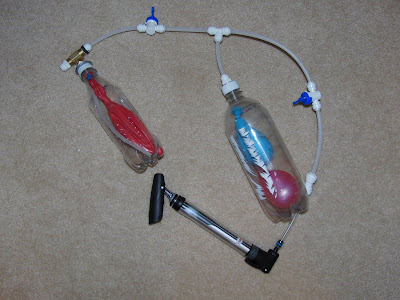After the abysmal failure of my carbonated soda tests, I went back to the drawing board and rethought the whole concept. I finally realized that I'd been a bit too ambitious, and needed to get back to basics.
Since plain old bottled water is already deployed in the cabin during ZeroG flights, I decided to build an experimental platform that would permit me to get good video (both regular and high-speed) of water spheres. I needed something that would let me get good images of fairly large blobs of water that were floating freely in the cabin, and also let me collect the water at the end of the free-fall segment. Here's what I came up with...
 The vertical frame mounts the camera and operator handles, and will also contain a set of high-intensity LuxStrip LED light bars to provide the light needed for the high-speed camera. The horizontal frame is the liquid-collection device, which is constructed out of plastic sheeting, the remains of 5 disposable diapers, and, of course, duct tape.
The vertical frame mounts the camera and operator handles, and will also contain a set of high-intensity LuxStrip LED light bars to provide the light needed for the high-speed camera. The horizontal frame is the liquid-collection device, which is constructed out of plastic sheeting, the remains of 5 disposable diapers, and, of course, duct tape.Everything is constructed out of T-slot extrusions and connectors from Amazing Robotics plus a few bits that I hacked together in my workshop.
 The nice big red handles are perfect for controlling the device, pointing the camera, and wicking up the water afterwards.
The nice big red handles are perfect for controlling the device, pointing the camera, and wicking up the water afterwards. The diaper+plastic sheet can be removed and replaced in flight; it attaches to a UHMW base plate via some velcro tabs.
The diaper+plastic sheet can be removed and replaced in flight; it attaches to a UHMW base plate via some velcro tabs. Finally, the whole thing folds flat; locking and unlocking is controlled by two wing-nuts; no tools required!
Finally, the whole thing folds flat; locking and unlocking is controlled by two wing-nuts; no tools required!Needless to say, if I can come up with an acronym for this device that matches a major diaper brand, the sponsorship opportunities are literally out of this world ("4 out of 5 incontinent free-falling mad scientists prefer Depends").
PS: Some things I learned while abuilding...
T-slot extrusion is great for these kind of prototyping projects; here are a few things I learned along the way.
- Most of the supplied nuts and bolts are 10-32. I happen to love 10-32 cap screws so I replaced them with some nice buttonheads.
- The big red handles use 1/4 bolts; the problem is that 1/4 nuts won't fit in the extrusion. The solution is to use flat automotive speed nuts and a little hackery. Speed nuts are weird spring-steel flat plate devices, and the 1/4 ones almost but not quite fit in the slots. To get them to fit, you do the following: thread a junk 1/4 bolt onto it (the bolt may get a little mangled), clamp one end in a vice, and use a tightened-up adjustable wrench to take the bow out of the nut, so it's pretty much flat. Once you've got it to where it will slide easily in the slot, remove the bolt and test out another one to make sure that the little fingers that grasp the bolt are not too loose, and not too tight. You may have to adjust them with the vise or pliers.
- A length of piano hinge with holes that are the right size for 10-32 bolts (any hardware store will have some, you can cut it to the length you need) will fold so that the sides are close to parallel if you secure it by alternating 10-32 buttonheads + a small washer (so that each buttonhead touches an empty hole on the other half of the hinge). The buttonheads act as spacers.
- The plastic corner connectors have fingers that have starter holes for small set-screws (you will understand what I mean if you get some). However, the cube-corner connectors (not actually used in my device) have one set of fingers that don't have the starter holes, probably because of a limitation in their manufacturing process. Just stuff the no-hole fingers into a bit of the t-slot extrusion and drill your own in using a #41 or so drill bit. Update: I've been told that you can also screw the set-screws into the ends of the fingers without drilling.
- One of the big pains with T-slot extrusion is when you realize that you need an extra square nut in a section to mount something, because this means you have to take things apart -- unless you know about a trick. It turns out that the 10-32 square nuts have enough variability in their size that some of them can be inserted directly into a slot. To find nuts with this property, slide a bunch of them into a slot, turn the extrusion so that slot is on the bottom, and shake the nuts back and forth; the special secret nuts will drop out. Repeat the process with the remaining nuts rotation 90-degrees, as usually only one axis is short. Set these nuts aside for emergencies. To insert a nut, put it into the slot, put your finger on it, turn so the slot is on the bottom, and slide the nut back and forth; it'll seat itself quite easily (assuming you've got the orientation correct, a 50-50 shot).









































